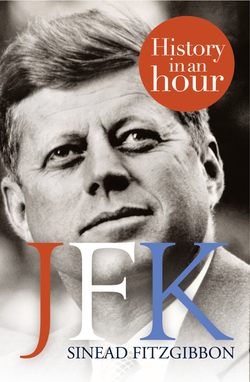Читать книгу JFK: History in an Hour - Sinead Fitzgibbon - Страница 8
ОглавлениеWar Service
The interventionist debate was rendered immaterial following the Japanese attack on Pearl Harbour on 7 December 1941 – an act of aggression which forced the US to declare war on Japan the following day.
Despite its relatively late entry into World War Two, the US was not unprepared for combat. Conscription had been re-introduced in September 1940 and Jack Kennedy was among the first to be called up for the draft. Unlike his father, who had avoided enlisting during World War One, the younger Kennedy was keen to play his part. Whether this eagerness to serve was due to a genuine sense of patriotic duty or competitiveness with his older brother, who had volunteered for the navy, is debatable. Regardless, he was refused admission to both the army and navy after failing medical examinations and left bitterly disappointed.
Kennedy aboard PT-109, 1943
Characteristically, the twenty-three-year-old refused to yield to this latest health-related setback and lobbied his father to intervene. Such was Joe Sr’s political influence that, in less than a month, his second son somehow managed to recover from his illness to be pronounced ‘physically qualified for appointment’ by a committee of medical examiners. In October 1941, Kennedy entered the United States Navy as a junior officer.
A brief stint in the Foreign Intelligence Branch of the Office of Naval Intelligence was brought to an abrupt end in early 1942 when Kennedy was transferred from Washington DC to Charleston Navy Yard in South Carolina. In March, his recurrent back pain became intolerable, forcing him to seek medical help from a number of specialists, none of whom could agree on a diagnosis. Disheartened by his persistent ailments and upset by the recent breakdown of his romantic relationship with a beautiful Danish reporter named Inga Arvad – at the time suspected of being a Nazi spy – Jack requested a deployment to sea.
Following an intensive sixty-day training course, he applied for the position of commander of a torpedo boat (also known as a Patrol Torpedo or PT), which were being used to attack Japanese ships in the Pacific. His back problems were initially expected to work against him, but again, some manoeuvrings by his father Joe Sr and his grandfather, Honey Fitz, navigated the problem. By March 1943, Lt Kennedy was posted to the Solomon Islands as commander of PT-109.
Behind Enemy Lines
Jack had never made any secret of his desire for front-line combat. This deployment to one of the central battlegrounds in the fierce fight for dominance in the Pacific would provide it.
On the night of 2 August PT-109 was on a routine patrol when it was rammed by a huge Japanese destroyer. Given the size differential, the small PT boat didn’t stand a chance – it was virtually sawn in half by the enemy ship, before bursting into flames. Lt Kennedy was at the helm at the time of collision, trying in vain to steer clear of the oncoming destroyer, and was flung violently against the wall by the force of the impact, badly injuring his already weak back.
He, however, was one of the lucky ones – of the twelve other crewmen on board, two lost their lives instantly. The remaining ten, along with Kennedy, were forced to abandon ship, plunged into the sea and had to cling to debris in order to remain afloat. Having sustained severe burns to his hands and face, one crewman, Patrick McMahon, struggled to reach the piece of floating hull that his comrades were using as a lifebuoy; Kennedy swam to the wounded man’s rescue and pulled him to safety.
JFK (far right) and crewmen of PT-109
After nine hours in the water, the men reached a cluster of small islands which were situated a few miles away from the collision site, behind enemy lines. Ignoring his own back injury, Jack had pulled McMahon the whole way by clamping a strap of his life jacket between his teeth, while the wounded man floated on his back.
Having been discovered by natives who were sympathetic to their plight (and who may, in fact, have been Allied scouts), Jack arranged for a coconut shell to be smuggled to the nearest US naval base. The shell had inscribed on it the following message:
NAURO ISL…COMMANDER…NATIVE KNOWS POS’IT…HE CAN PILOT…11 ALIVE…NEED SMALL BOAT…KENNEDY.
The following morning, eight islanders arrived with food and water. They then concealed Kennedy under palm fronds and delivered him to Gamu, a nearby island where the local Allied coastwatcher could be found. From there, and with the help of the coastwatcher, Kennedy orchestrated the rescue of the rest of the crew, which was carried out under cover of darkness in the small hours of 8 August. The operation was a success. After six long days, the ordeal was over.
Coconut shell with distress message
Kennedy’s remarkable resourcefulness saved not only his own life but also the lives of his surviving ten crewmen. When news of his exploits reached US shores, he was lauded as a hero. In recognition of his bravery and leadership, he was awarded the Navy and Marine Corps Medal in June 1944, while the injuries to his back earned him the Purple Heart Medal.
Receiving Navy and Marine Corps Medal from Captain Frederick Conklin
There was, however, another memento that Jack seemed to value more than anything else. Upon returning home, he had the life-saving coconut shell mounted on a wooden base and enshrined in a plastic dome. The resulting paperweight remained in his possession for the rest of his life, and when he became President, it took pride of place on his desk in the Oval Office.
